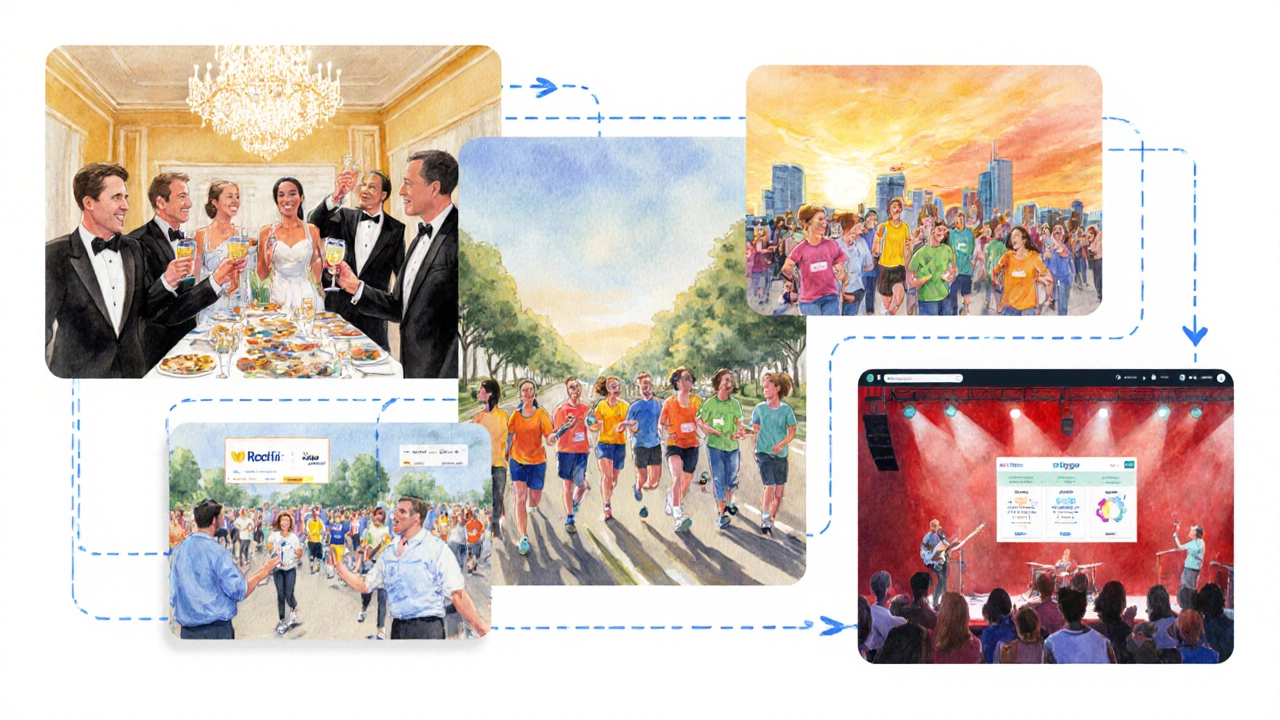Charity events aren't just about dressing up or sharing a nice meal—they have concrete objectives that help drive change. This article breaks down what these events really aim to accomplish, from gathering money and raising awareness to building community. You'll discover practical tips to make charity events more effective and engaging. We’ll even toss in some surprising facts about how small efforts can have a big impact. Whether you're planning your first fundraiser or just curious how these gatherings work, you'll get what you need right here.

- Created by: Lydia Carmichael
- Completed on: 13 Oct 2025
- Categories: Charities
Charity Event Budget Calculator
Net Revenue: $0.00
Overhead Percentage: 0%
Program Cost Percentage: 100%
Impact of your funds: This event could provide 0 tutoring hours, or 0 meals for those in need.
When you hear the term charity event a gathering organized to raise funds or awareness for a cause, usually run by a nonprofit organization, you might picture a fancy gala or a local fun run. In reality, a charity event can be anything from a bake sale in a school cafeteria to a virtual marathon streamed worldwide.
Key Takeaways
- Charity events are tools for nonprofits to raise money, awareness, and community support.
- Common formats include galas, walks/runs, auctions, concerts, and online campaigns.
- Successful events need clear goals, a solid budget, engaged volunteers, and right sponsors.
- Participants can contribute as donors, volunteers, or beneficiaries.
- Legal compliance and post‑event reporting are essential for trust and repeat success.
What Exactly Is a Charity Event?
A charity event is any organized activity whose primary purpose is to generate financial support or increase public awareness for a charitable cause. Unlike commercial events that aim for profit, the revenue from a charity event goes directly (or after covering minimal costs) to a nonprofit organization an entity that operates for public benefit rather than private gain, often holding 501(c)(3) status in the U.S.. The event can be one‑off or recurring, in‑person or virtual, and may target a local community or a global audience.
Why Host a Charity Event?
Nonprofits use events for three core reasons:
- Fundraising: Direct cash donations, ticket sales, or auction proceeds fund programs.
- Awareness Building: Media coverage and social sharing spread the mission.
- Community Engagement: Volunteers and donors feel connected, boosting long‑term loyalty.
Each reason amplifies the others. For example, a well‑publicized walkathon not only raises money through registration fees but also educates participants about the cause, prompting future donations.
Common Types of Charity Events
| Format | Typical Audience | Revenue Streams | Best For |
|---|---|---|---|
| Gala/Dinner | Corporate donors, philanthropists | Ticket sales, live auction, sponsorship | High‑budget causes, prestige branding |
| Walk/Run | d>Families, fitness enthusiasts | Registration fees, pledges, merchandise | Health, youth, community projects |
| Silent/Live Auction | Collectors, local businesses | Item bids, sponsor packages | Art, cultural, heritage funds |
| Concert/Performance | Music lovers, general public | Ticket sales, merchandise, sponsorship | Youth programs, disaster relief |
| Online Crowdfunding Campaign | Global internet audience | Digital donations, merchandise | Emergency response, tech‑based initiatives |

Step‑by‑Step Guide to Planning a Charity Event
Planning can feel overwhelming, but breaking it into clear phases helps keep things on track.
- Define the Goal: Set a specific fundraising target and a measurable awareness metric (e.g., 1,000 social shares).
- Choose the Format: Match the goal with a suitable event type from the table above.
- Create a Budget: List all expected expenses-venue, catering, permits, marketing-and allocate a contingency of 10‑15%.
- Secure a Sponsor: Approach businesses for in‑kind donations or cash sponsorship. A sponsor a company or individual that provides financial or material support in exchange for branding exposure can cover venue costs, reducing the net amount needed from donors.
- Recruit Volunteers: Use a volunteer someone who donates time and skills to help run the event without pay pool for registration desks, logistics, and promotion.
- Promote the Event: Leverage email newsletters, social media, local press, and community boards. Create a simple hashtag and encourage participants to share.
- Engage Donors: Identify donors individuals or entities that contribute money or assets to the cause early with personalized outreach; offer tiered recognition (e.g., bronze, silver).
- Execute on the Day: Follow a detailed run‑sheet, keep lines of communication open, and have a contingency plan for weather or technical glitches.
- Follow Up: Send thank‑you notes, share impact results, and disclose how the funds will be used. Transparency builds trust for future events.
Key Roles: Who Does What?
A successful event relies on a few core participants:
- Organizer (often the nonprofit): Sets objectives, secures permits, and oversees the budget.
- Volunteer Coordinator: Recruits and schedules volunteers.
- Fundraising Manager: Engages donors and sponsors, tracks pledges.
- Marketing Lead: Crafts messaging, designs graphics, handles media outreach.
- Beneficiary Representative: Communicates the real‑world impact; helps donors see where their money goes. A beneficiary the person, group, or community that receives aid or services from the charitable program can share a short story at the event to boost emotional connection.
Legal and Ethical Considerations
Even small charity events must follow regulations to protect donors and maintain credibility.
- Registration: Most jurisdictions require nonprofits to register the fundraiser with a state charity office.
- Tax Receipts: Issue proper receipts for tax‑deductible donations; include the nonprofit’s EIN.
- Transparency: Disclose how much of the money raised will go to program expenses versus overhead.
- Insurance: Event liability insurance protects against accidents, especially for physical activities.
- Data Privacy: Safeguard donor information per GDPR (if EU participants) or similar laws.
Measuring Community Impact
Beyond dollars raised, the true success of a charity event lies in its lasting effect. Track metrics such as:
- Number of new volunteers recruited.
- Media impressions and social engagement.
- Follow‑up donations within six months.
- Specific outcomes achieved with the funds (e.g., 50 meals provided, 200 children enrolled in after‑school programs).
Share these results in a post‑event report. Donors love numbers-they reveal exactly how their contribution changed lives.

Common Pitfalls and How to Avoid Them
- Undefined Goal: Without a clear target, budgeting and promotion become vague. Set a SMART goal from day one.
- Underestimating Costs: Hidden fees (permits, security, décor) can eat profits. Build a 10‑15% contingency.
- Over‑reliance on One Sponsor: If the sponsor pulls out, the event can collapse. Diversify funding sources.
- Poor Volunteer Management: No schedule or training leads to chaos. Use a simple sign‑up tool and brief volunteers beforehand.
- Lack of Follow‑Up: Failing to thank donors lowers future giving chances. Automate thank‑you emails within 48 hours.
Real‑World Example: The Downtown 5K Run for Youth Programs
Last spring, a midsized city’s youth nonprofit organized a 5K run. Here’s a snapshot of how they applied the guide above:
- Goal: Raise $25,000 for after‑school tutoring.
- Format: Walk/run, appealing to families.
- Budget: $6,000 (permits, T‑shirts, timing chip).
- Sponsor: Local gym covered the timing chip; a bakery donated post‑race treats.
- Volunteers: 30 community members handled registration and water stations.
- Promotion: Leveraged Instagram, local radio, and school newsletters.
- Outcome: Collected $28,500, recruited 45 new volunteers, and secured a recurring $5,000 pledge from a corporate donor impressed by the turnout.
The post‑event report highlighted that every dollar raised funded 20 tutoring hours, a concrete metric that resonated with donors when the nonprofit posted a follow‑up video.
Getting Started: Your First Charity Event Checklist
- Write a one‑sentence mission statement for the event.
- Select a date that doesn’t clash with major holidays.
- Identify a venue or decide on a virtual platform.
- Draft a simple budget template (expenses vs. projected revenue).
- Reach out to at least three potential sponsors.
- Post a volunteer sign‑up link on your website and social channels.
- Design a basic flyer or social graphic with the event hashtag.
- Register the fundraiser with your state’s charity office (if required).
- Plan a post‑event thank‑you email and impact summary.
Frequently Asked Questions
Do I need a nonprofit status to host a charity event?
While a recognized nonprofit makes tax‑deductible donations possible, anyone can host a fundraiser. However, if you want donors to claim tax benefits, the event must be tied to a registered 501(c)(3) or equivalent entity.
How much of the money raised should cover event costs?
Best practice is to keep overhead under 20% of total revenue. Transparent reporting on these percentages builds donor confidence.
Can I run a charity event online?
Absolutely. Virtual concerts, live‑streamed challenges, and crowdfunding platforms let you reach global audiences while saving on venue costs.
What legal documents do I need?
Typically you’ll need a fundraising permit, liability insurance certificate, and, if you’re issuing tax receipts, the nonprofit’s EIN and a written acknowledgment of each donation.
How can I attract sponsors?
Create a sponsorship packet that outlines audience demographics, branding opportunities (logos on flyers, booth space), and the impact their support will have. Start with local businesses that share your mission.
Whether you’re planning a modest bake sale or a high‑profile gala, remember that the core of any charity event is connection-linking generous people to a cause that matters. With clear goals, solid planning, and open communication, your event can turn goodwill into real change.
Learn what a charity event is, explore common formats, get a step‑by‑step planning guide, and discover tips for volunteers, sponsors, and donors.
